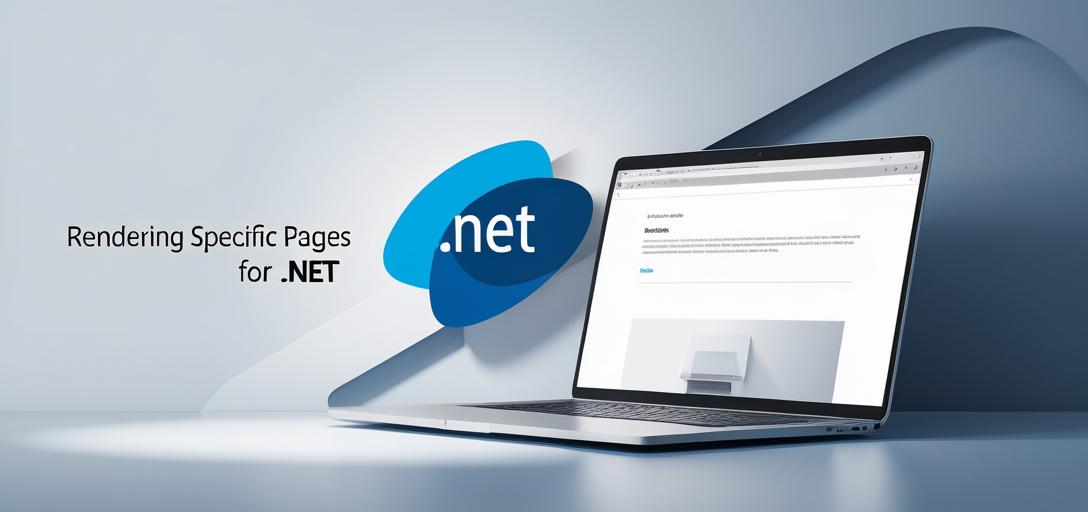Rendering Specific Pages in .NET with GroupDocs.Viewer: A Comprehensive Guide
Introduction
In the digital age, rendering specific sections of large documents can significantly streamline workflows and boost productivity. This tutorial will show you how to use GroupDocs.Viewer for .NET to selectively render pages from your documents—a crucial skill for businesses that need quick access to particular information without processing entire files.

What You’ll Learn:
- Configuring GroupDocs.Viewer for .NET to render a specified range of document pages.
- Best practices for setting up and integrating the library into your projects.
- Optimization techniques to enhance performance when rendering documents.
With these insights in mind, let’s get started with what you need before diving into this powerful tool.
Prerequisites
Before implementing GroupDocs.Viewer for .NET, ensure that you have the necessary environment set up. Here’s what you’ll need:
Required Libraries and Dependencies
- GroupDocs.Viewer for .NET: The primary library used to render document pages.
- .NET Framework/SDK: Ensure compatibility with your project requirements.
Environment Setup Requirements
- A development environment like Visual Studio or any compatible IDE that supports .NET projects.
Knowledge Prerequisites
- Basic understanding of C# and the .NET framework.
- Familiarity with file I/O operations in C#.
With these prerequisites covered, let’s set up GroupDocs.Viewer for .NET to start rendering document pages efficiently.
Setting Up GroupDocs.Viewer for .NET
To begin using GroupDocs.Viewer, you need to install it. This can be done via NuGet Package Manager or .NET CLI:
NuGet Package Manager Console
Install-Package GroupDocs.Viewer -Version 25.3.0
.NET CLI
dotnet add package GroupDocs.Viewer --version 25.3.0
License Acquisition
GroupDocs offers different licensing options:
- Free Trial: Download a trial version to test the features.
- Temporary License: Request a temporary license for extended testing.
- Purchase License: For full access, purchase a license.
Once you have your license, proceed with basic initialization and setup in C#:
using GroupDocs.Viewer;
// Initialize Viewer object with document path
string documentPath = "YOUR_DOCUMENT_DIRECTORY/SAMPLE_DOCX";
Viewer viewer = new Viewer(documentPath);
// Always remember to dispose of resources properly
viewer.Dispose();
This simple setup is your entry point into rendering documents.
Implementation Guide
The core feature we’ll focus on here is rendering a specified range of pages. Here’s how you can achieve this with GroupDocs.Viewer for .NET:
Rendering a Range of Pages (Feature Overview)
GroupDocs.Viewer allows selective page rendering, saving time and resources by focusing only on necessary sections.
Step-by-Step Implementation
1. Define Input and Output Directories
Set up paths for the source document and output directory where rendered pages will be saved:
string documentPath = "YOUR_DOCUMENT_DIRECTORY/SAMPLE_DOCX";
string outputDirectory = "YOUR_OUTPUT_DIRECTORY";
2. Create Page File Path Format
Specify a naming pattern for each page file to organize outputs effectively:
string pageFilePathFormat = Path.Combine(outputDirectory, "page_{0}.html");
3. Specify Page Range
Determine which pages you need. Here, we target the first three pages:
int[] range = Enumerable.Range(1, 3).ToArray(); // Pages 1 to 3
4. Initialize Viewer and Configure Options
Set up the viewer with the document path and configure options for rendering:
using (Viewer viewer = new Viewer(documentPath))
{
HtmlViewOptions options = HtmlViewOptions.ForEmbeddedResources(pageFilePathFormat);
// Render specified page range
viewer.View(options, range);
}
Parameters Explained:
- HtmlViewOptions: Configures how pages are rendered;
ForEmbeddedResourcesspecifies that all resources should be embedded. - Range Array: Defines which pages to render.
Troubleshooting Tips
Common issues may arise during implementation. Here are some tips:
- Ensure file paths are correct and accessible.
- Verify the document format is supported by GroupDocs.Viewer.
Practical Applications
GroupDocs.Viewer for .NET can be integrated into various systems, offering numerous practical applications:
- Intranet Document Management: Streamline internal documentation access by rendering specific pages for different departments.
- E-Learning Platforms: Deliver course materials efficiently by selectively sharing necessary document sections with students.
- Legal and Compliance Departments: Quickly access pertinent sections of lengthy contracts or compliance documents.
These examples demonstrate the flexibility and power of GroupDocs.Viewer in diverse environments.
Performance Considerations
Optimizing performance is crucial when rendering large documents:
- Resource Management: Ensure proper disposal of viewer resources to prevent memory leaks.
- Batch Processing: Render pages in batches if dealing with exceptionally large documents.
- Asynchronous Operations: Utilize asynchronous methods where possible to enhance responsiveness.
By adhering to these best practices, you can maintain efficient resource usage and maximize performance with GroupDocs.Viewer for .NET.
Conclusion
Throughout this tutorial, we’ve explored how to implement the rendering of specific page ranges using GroupDocs.Viewer for .NET. By following the outlined steps and considering practical applications, you’re well-equipped to integrate this feature into your projects.
As next steps, consider exploring advanced features or integrating with other systems to further enhance functionality. Don’t hesitate to experiment—your feedback can lead to even more robust solutions!
FAQ Section
1. Can GroupDocs.Viewer handle all document formats? Yes, it supports a wide range of formats including DOCX, PDF, and many others.
2. How do I optimize performance for large documents? Use batch processing and manage resources efficiently to improve rendering times.
3. Is there support for asynchronous operations in GroupDocs.Viewer? While primarily synchronous, certain methods can be adapted for async use, improving UI responsiveness.
4. What are some common issues with setting up GroupDocs.Viewer? Incorrect file paths or unsupported document formats often cause setup errors.
5. How do I troubleshoot rendering issues? Check your configurations and ensure all resources are properly disposed of after use.
Resources
- Documentation: GroupDocs Viewer .NET Documentation
- API Reference: GroupDocs API Reference
- Download: Latest Release
- Purchase: Buy GroupDocs License
- Free Trial: Trial Version
- Temporary License: Request Temporary License
- Support: GroupDocs Support Forum
This tutorial has laid out a comprehensive path for implementing GroupDocs.Viewer for .NET in your projects. With these insights and resources, you’re ready to harness the full potential of document rendering in .NET environments.